Disruptive Innovation: A Study of Trends in Global Business
VerifiedAdded on 2023/06/15
|11
|2496
|391
Essay
AI Summary
This essay examines the concept of disruptive innovation in the modern business environment, focusing on its application and impact on the hotel and taxi industries, specifically comparing Uber and Airbnb. It delves into the misconceptions surrounding disruptive innovation, highlighting that while Uber is often cited as an example, it doesn't fully align with the theory's classic definition, whereas Airbnb demonstrates a more accurate application. The essay also addresses the relationship between quality and mainstream customers in the context of disruptive innovation, noting that incumbent customers prioritize quality over cost savings and are less likely to switch to disruptive innovators unless the quality of existing services declines. Furthermore, it interprets the mantra of 'disrupt or be disrupted,' suggesting that incumbent organizations should focus on sustaining innovation and strengthening their core business while acknowledging the opportunities for growth presented by disruptive forces. The essay concludes that disruptive innovation is a major driving force, and organizations must adapt to compete effectively by providing quality services and capitalizing on new opportunities.
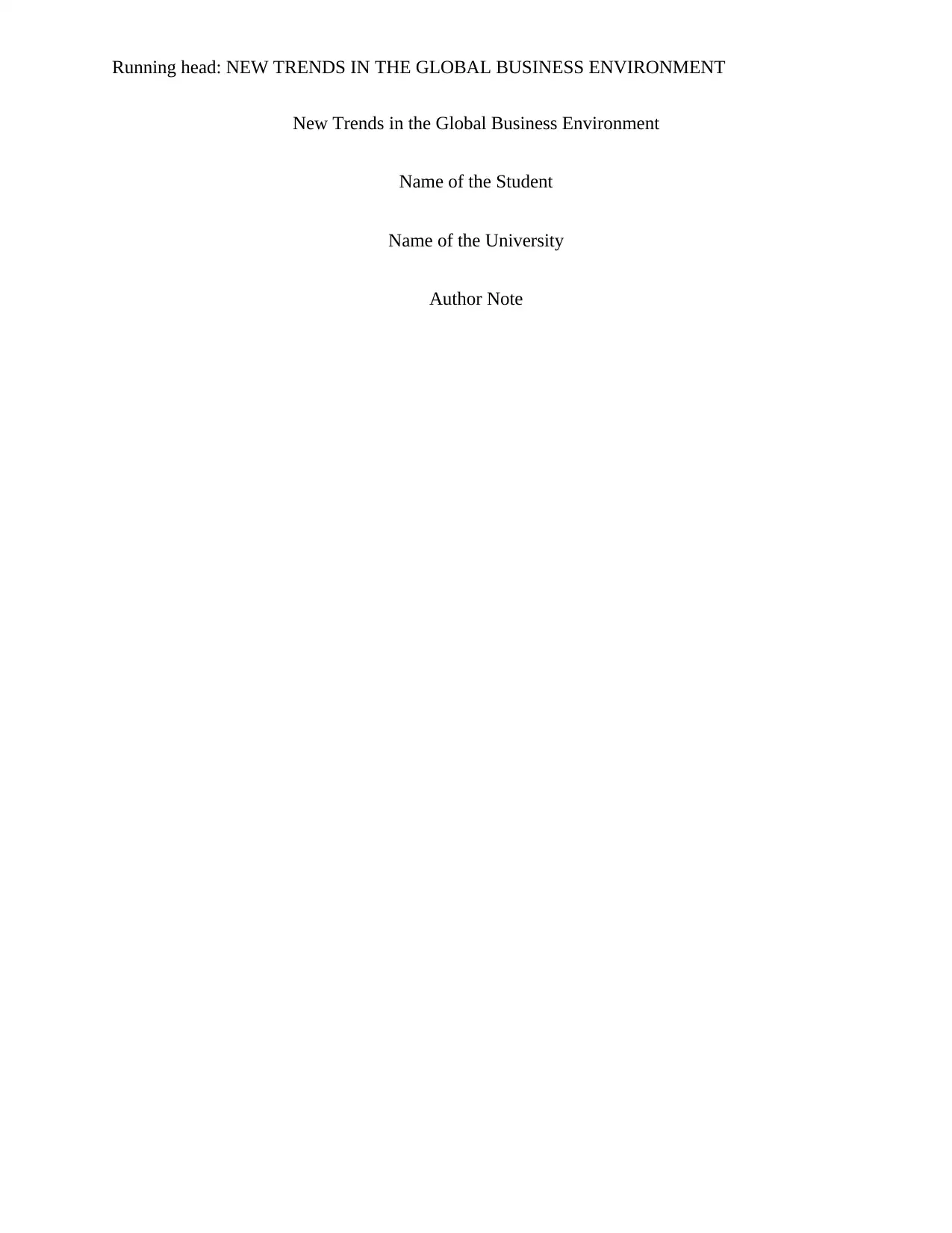
Running head: NEW TRENDS IN THE GLOBAL BUSINESS ENVIRONMENT
New Trends in the Global Business Environment
Name of the Student
Name of the University
Author Note
New Trends in the Global Business Environment
Name of the Student
Name of the University
Author Note
Paraphrase This Document
Need a fresh take? Get an instant paraphrase of this document with our AI Paraphraser
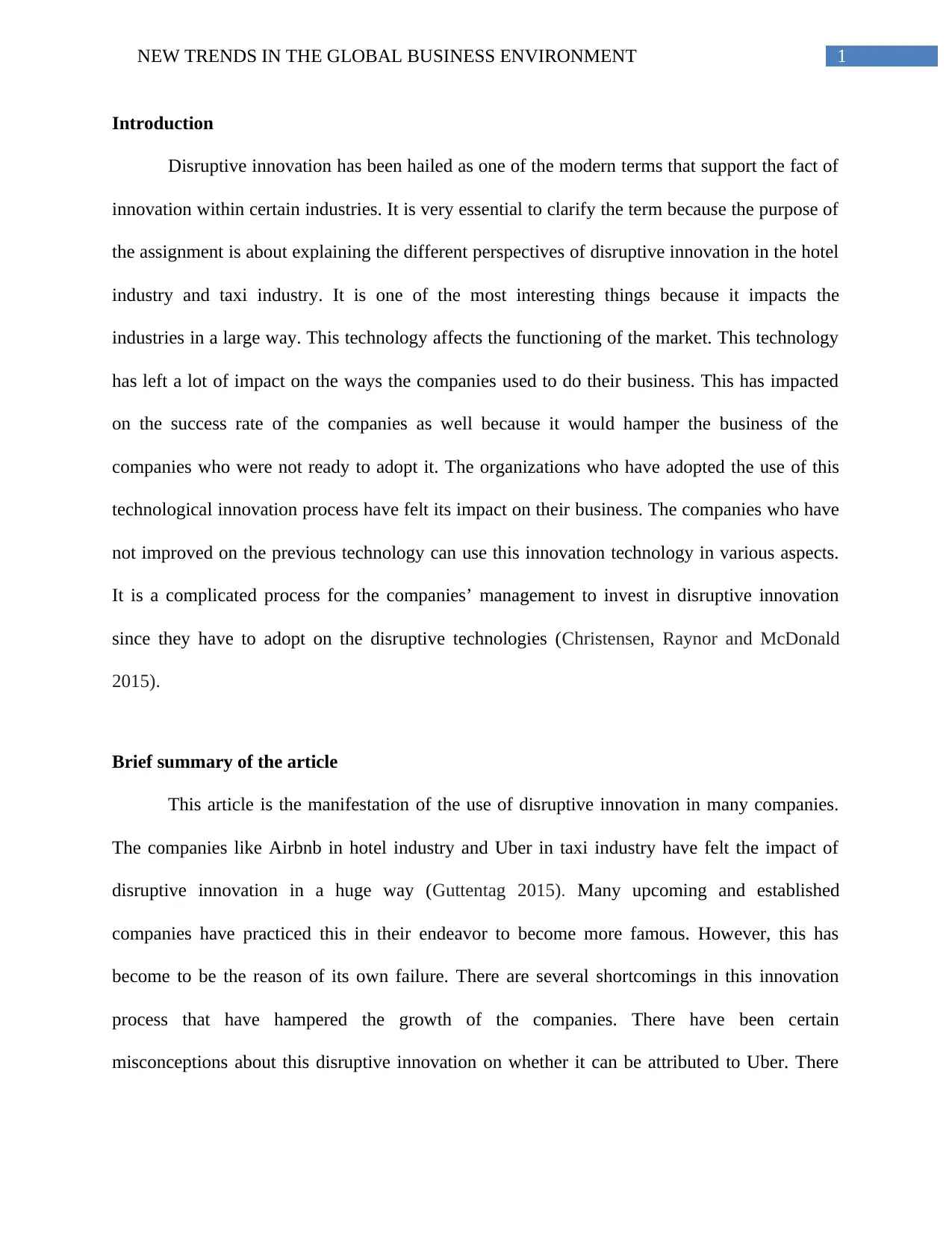
1NEW TRENDS IN THE GLOBAL BUSINESS ENVIRONMENT
Introduction
Disruptive innovation has been hailed as one of the modern terms that support the fact of
innovation within certain industries. It is very essential to clarify the term because the purpose of
the assignment is about explaining the different perspectives of disruptive innovation in the hotel
industry and taxi industry. It is one of the most interesting things because it impacts the
industries in a large way. This technology affects the functioning of the market. This technology
has left a lot of impact on the ways the companies used to do their business. This has impacted
on the success rate of the companies as well because it would hamper the business of the
companies who were not ready to adopt it. The organizations who have adopted the use of this
technological innovation process have felt its impact on their business. The companies who have
not improved on the previous technology can use this innovation technology in various aspects.
It is a complicated process for the companies’ management to invest in disruptive innovation
since they have to adopt on the disruptive technologies (Christensen, Raynor and McDonald
2015).
Brief summary of the article
This article is the manifestation of the use of disruptive innovation in many companies.
The companies like Airbnb in hotel industry and Uber in taxi industry have felt the impact of
disruptive innovation in a huge way (Guttentag 2015). Many upcoming and established
companies have practiced this in their endeavor to become more famous. However, this has
become to be the reason of its own failure. There are several shortcomings in this innovation
process that have hampered the growth of the companies. There have been certain
misconceptions about this disruptive innovation on whether it can be attributed to Uber. There
Introduction
Disruptive innovation has been hailed as one of the modern terms that support the fact of
innovation within certain industries. It is very essential to clarify the term because the purpose of
the assignment is about explaining the different perspectives of disruptive innovation in the hotel
industry and taxi industry. It is one of the most interesting things because it impacts the
industries in a large way. This technology affects the functioning of the market. This technology
has left a lot of impact on the ways the companies used to do their business. This has impacted
on the success rate of the companies as well because it would hamper the business of the
companies who were not ready to adopt it. The organizations who have adopted the use of this
technological innovation process have felt its impact on their business. The companies who have
not improved on the previous technology can use this innovation technology in various aspects.
It is a complicated process for the companies’ management to invest in disruptive innovation
since they have to adopt on the disruptive technologies (Christensen, Raynor and McDonald
2015).
Brief summary of the article
This article is the manifestation of the use of disruptive innovation in many companies.
The companies like Airbnb in hotel industry and Uber in taxi industry have felt the impact of
disruptive innovation in a huge way (Guttentag 2015). Many upcoming and established
companies have practiced this in their endeavor to become more famous. However, this has
become to be the reason of its own failure. There are several shortcomings in this innovation
process that have hampered the growth of the companies. There have been certain
misconceptions about this disruptive innovation on whether it can be attributed to Uber. There
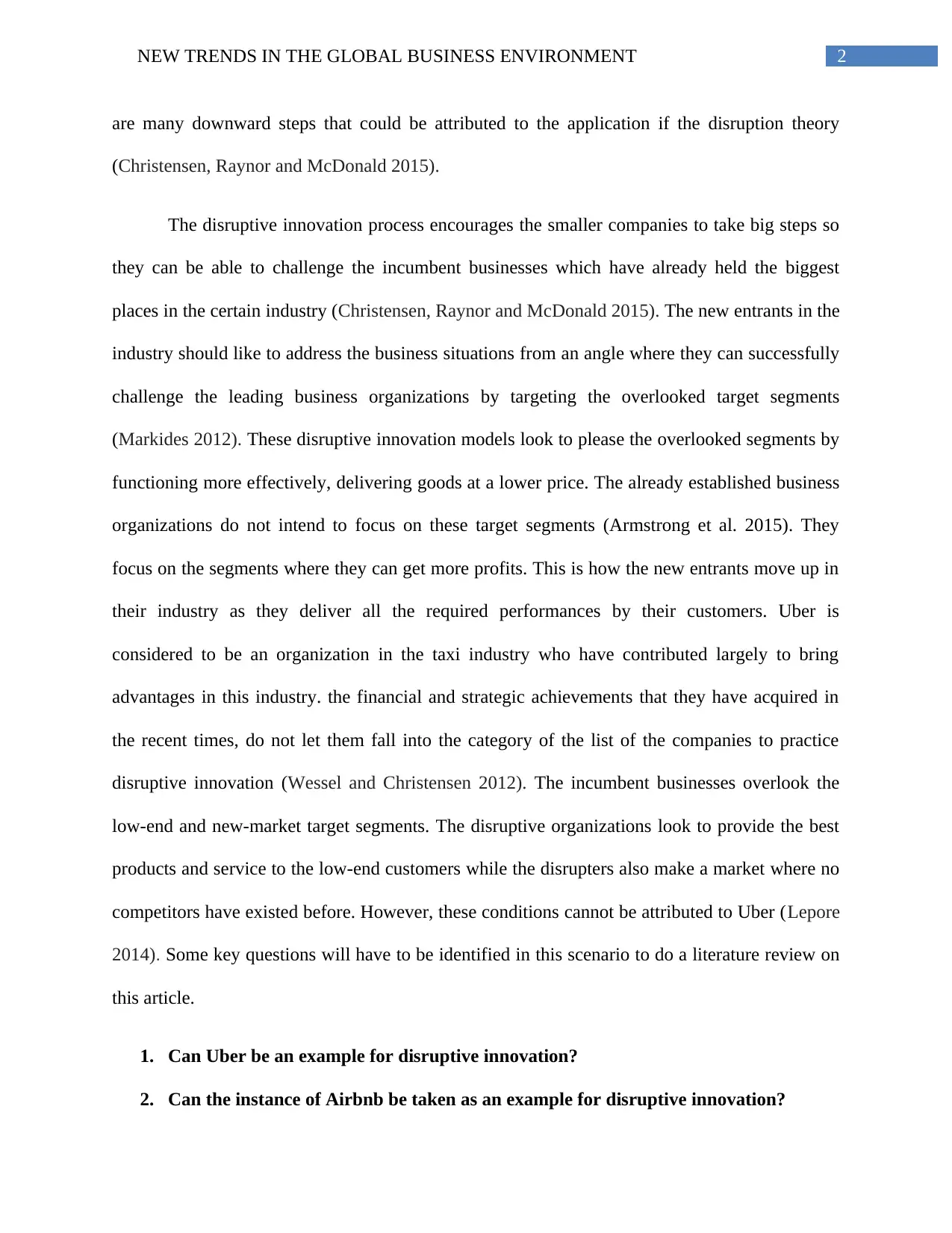
2NEW TRENDS IN THE GLOBAL BUSINESS ENVIRONMENT
are many downward steps that could be attributed to the application if the disruption theory
(Christensen, Raynor and McDonald 2015).
The disruptive innovation process encourages the smaller companies to take big steps so
they can be able to challenge the incumbent businesses which have already held the biggest
places in the certain industry (Christensen, Raynor and McDonald 2015). The new entrants in the
industry should like to address the business situations from an angle where they can successfully
challenge the leading business organizations by targeting the overlooked target segments
(Markides 2012). These disruptive innovation models look to please the overlooked segments by
functioning more effectively, delivering goods at a lower price. The already established business
organizations do not intend to focus on these target segments (Armstrong et al. 2015). They
focus on the segments where they can get more profits. This is how the new entrants move up in
their industry as they deliver all the required performances by their customers. Uber is
considered to be an organization in the taxi industry who have contributed largely to bring
advantages in this industry. the financial and strategic achievements that they have acquired in
the recent times, do not let them fall into the category of the list of the companies to practice
disruptive innovation (Wessel and Christensen 2012). The incumbent businesses overlook the
low-end and new-market target segments. The disruptive organizations look to provide the best
products and service to the low-end customers while the disrupters also make a market where no
competitors have existed before. However, these conditions cannot be attributed to Uber (Lepore
2014). Some key questions will have to be identified in this scenario to do a literature review on
this article.
1. Can Uber be an example for disruptive innovation?
2. Can the instance of Airbnb be taken as an example for disruptive innovation?
are many downward steps that could be attributed to the application if the disruption theory
(Christensen, Raynor and McDonald 2015).
The disruptive innovation process encourages the smaller companies to take big steps so
they can be able to challenge the incumbent businesses which have already held the biggest
places in the certain industry (Christensen, Raynor and McDonald 2015). The new entrants in the
industry should like to address the business situations from an angle where they can successfully
challenge the leading business organizations by targeting the overlooked target segments
(Markides 2012). These disruptive innovation models look to please the overlooked segments by
functioning more effectively, delivering goods at a lower price. The already established business
organizations do not intend to focus on these target segments (Armstrong et al. 2015). They
focus on the segments where they can get more profits. This is how the new entrants move up in
their industry as they deliver all the required performances by their customers. Uber is
considered to be an organization in the taxi industry who have contributed largely to bring
advantages in this industry. the financial and strategic achievements that they have acquired in
the recent times, do not let them fall into the category of the list of the companies to practice
disruptive innovation (Wessel and Christensen 2012). The incumbent businesses overlook the
low-end and new-market target segments. The disruptive organizations look to provide the best
products and service to the low-end customers while the disrupters also make a market where no
competitors have existed before. However, these conditions cannot be attributed to Uber (Lepore
2014). Some key questions will have to be identified in this scenario to do a literature review on
this article.
1. Can Uber be an example for disruptive innovation?
2. Can the instance of Airbnb be taken as an example for disruptive innovation?
⊘ This is a preview!⊘
Do you want full access?
Subscribe today to unlock all pages.

Trusted by 1+ million students worldwide
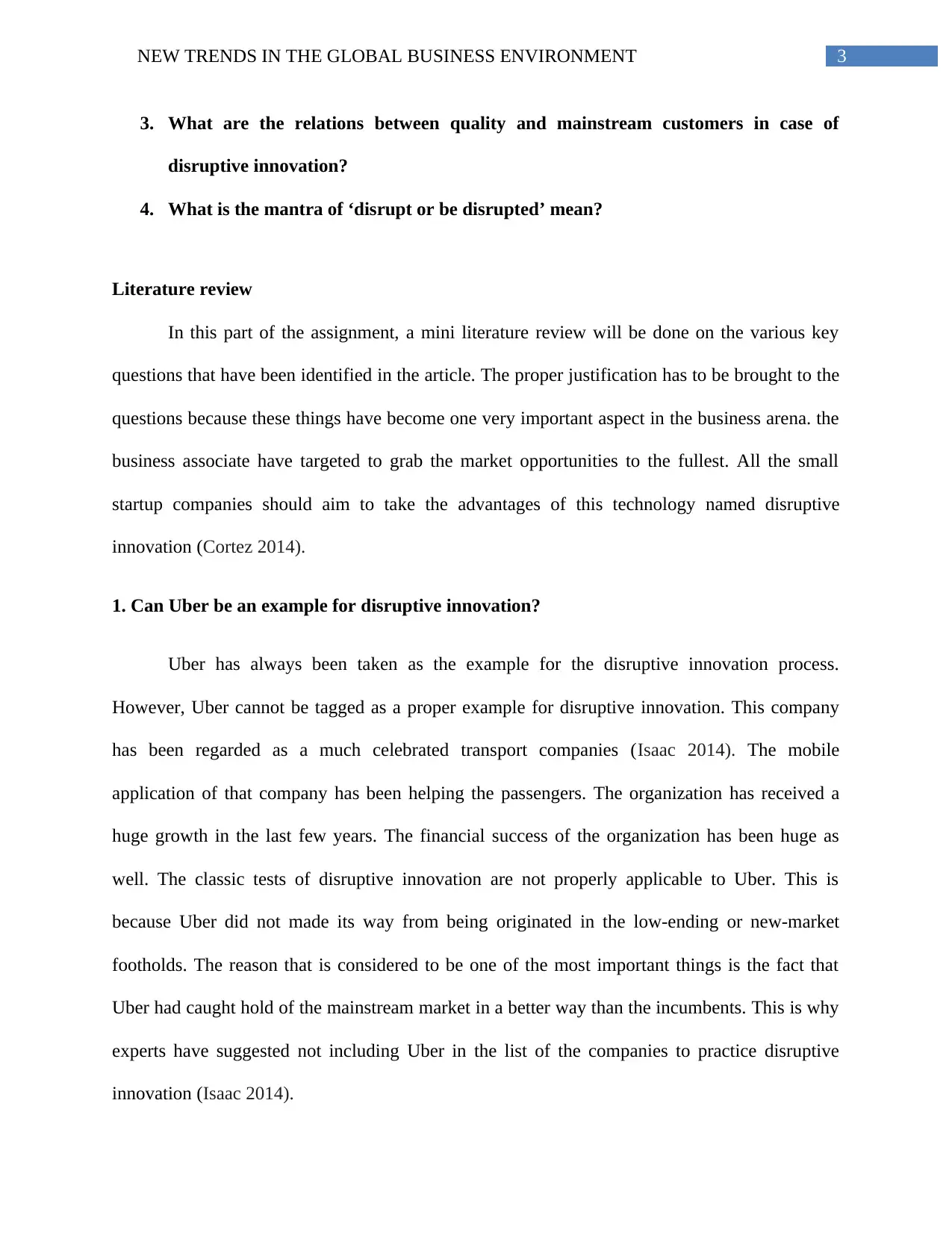
3NEW TRENDS IN THE GLOBAL BUSINESS ENVIRONMENT
3. What are the relations between quality and mainstream customers in case of
disruptive innovation?
4. What is the mantra of ‘disrupt or be disrupted’ mean?
Literature review
In this part of the assignment, a mini literature review will be done on the various key
questions that have been identified in the article. The proper justification has to be brought to the
questions because these things have become one very important aspect in the business arena. the
business associate have targeted to grab the market opportunities to the fullest. All the small
startup companies should aim to take the advantages of this technology named disruptive
innovation (Cortez 2014).
1. Can Uber be an example for disruptive innovation?
Uber has always been taken as the example for the disruptive innovation process.
However, Uber cannot be tagged as a proper example for disruptive innovation. This company
has been regarded as a much celebrated transport companies (Isaac 2014). The mobile
application of that company has been helping the passengers. The organization has received a
huge growth in the last few years. The financial success of the organization has been huge as
well. The classic tests of disruptive innovation are not properly applicable to Uber. This is
because Uber did not made its way from being originated in the low-ending or new-market
footholds. The reason that is considered to be one of the most important things is the fact that
Uber had caught hold of the mainstream market in a better way than the incumbents. This is why
experts have suggested not including Uber in the list of the companies to practice disruptive
innovation (Isaac 2014).
3. What are the relations between quality and mainstream customers in case of
disruptive innovation?
4. What is the mantra of ‘disrupt or be disrupted’ mean?
Literature review
In this part of the assignment, a mini literature review will be done on the various key
questions that have been identified in the article. The proper justification has to be brought to the
questions because these things have become one very important aspect in the business arena. the
business associate have targeted to grab the market opportunities to the fullest. All the small
startup companies should aim to take the advantages of this technology named disruptive
innovation (Cortez 2014).
1. Can Uber be an example for disruptive innovation?
Uber has always been taken as the example for the disruptive innovation process.
However, Uber cannot be tagged as a proper example for disruptive innovation. This company
has been regarded as a much celebrated transport companies (Isaac 2014). The mobile
application of that company has been helping the passengers. The organization has received a
huge growth in the last few years. The financial success of the organization has been huge as
well. The classic tests of disruptive innovation are not properly applicable to Uber. This is
because Uber did not made its way from being originated in the low-ending or new-market
footholds. The reason that is considered to be one of the most important things is the fact that
Uber had caught hold of the mainstream market in a better way than the incumbents. This is why
experts have suggested not including Uber in the list of the companies to practice disruptive
innovation (Isaac 2014).
Paraphrase This Document
Need a fresh take? Get an instant paraphrase of this document with our AI Paraphraser

4NEW TRENDS IN THE GLOBAL BUSINESS ENVIRONMENT
Before beginning their business in the taxi industry, Uber had started its business in the
Black limousine car services. The tag of being a company encouraging disruptive innovation can
be given to them in the scenario when they did their operations in the black limousine car
services. The origins of Uber and its growth suggest that they have crossed an up-market path to
crawl up so much. Uber has been direct competition from the beginning of their operations in the
industry so they cannot be called as an example of the disruptive innovation.
2. Can the instance of Airbnb be taken as an example for disruptive innovation?
The rise of the disruptive innovation theory can best be viewed and attributed to the case
of Airbnb and similar other views. The accommodations provided by Airbnb have been used by
several people. This has been one of the best instances of disruptive innovation. This is because
they have served the customers as a hotel substitute (Guttentag 2015) They wanted to improve
the hospitality for the travelers and they wanted to democratize their hotels by the use of the
sharing economy (Zervas, Proserpio and Byers 2014). They had been trying to capture the
attention of the travelers by improving on their services and providing them with meeting the
requirements that were not being made till date. This is one of the most successful strategic steps
that they had taken in order to improve their business position. The sharing economy had helped
them to a big deal as well (Guttentag 2015) The turnaround began to happen when all the hotels
in San Francisco were sold out and the rest of the travelers had to be left out who were not able
to accommodate themselves with high rents. Airbnb came to be their rescuer when the founders
decided to rent out air mattresses on the floor of their San Francisco branch. This became the
main turning pont for Airbnb. This is why disruptive innovation tag can be attributed to Airbnb
positively (Guttentag 2015)
Before beginning their business in the taxi industry, Uber had started its business in the
Black limousine car services. The tag of being a company encouraging disruptive innovation can
be given to them in the scenario when they did their operations in the black limousine car
services. The origins of Uber and its growth suggest that they have crossed an up-market path to
crawl up so much. Uber has been direct competition from the beginning of their operations in the
industry so they cannot be called as an example of the disruptive innovation.
2. Can the instance of Airbnb be taken as an example for disruptive innovation?
The rise of the disruptive innovation theory can best be viewed and attributed to the case
of Airbnb and similar other views. The accommodations provided by Airbnb have been used by
several people. This has been one of the best instances of disruptive innovation. This is because
they have served the customers as a hotel substitute (Guttentag 2015) They wanted to improve
the hospitality for the travelers and they wanted to democratize their hotels by the use of the
sharing economy (Zervas, Proserpio and Byers 2014). They had been trying to capture the
attention of the travelers by improving on their services and providing them with meeting the
requirements that were not being made till date. This is one of the most successful strategic steps
that they had taken in order to improve their business position. The sharing economy had helped
them to a big deal as well (Guttentag 2015) The turnaround began to happen when all the hotels
in San Francisco were sold out and the rest of the travelers had to be left out who were not able
to accommodate themselves with high rents. Airbnb came to be their rescuer when the founders
decided to rent out air mattresses on the floor of their San Francisco branch. This became the
main turning pont for Airbnb. This is why disruptive innovation tag can be attributed to Airbnb
positively (Guttentag 2015)
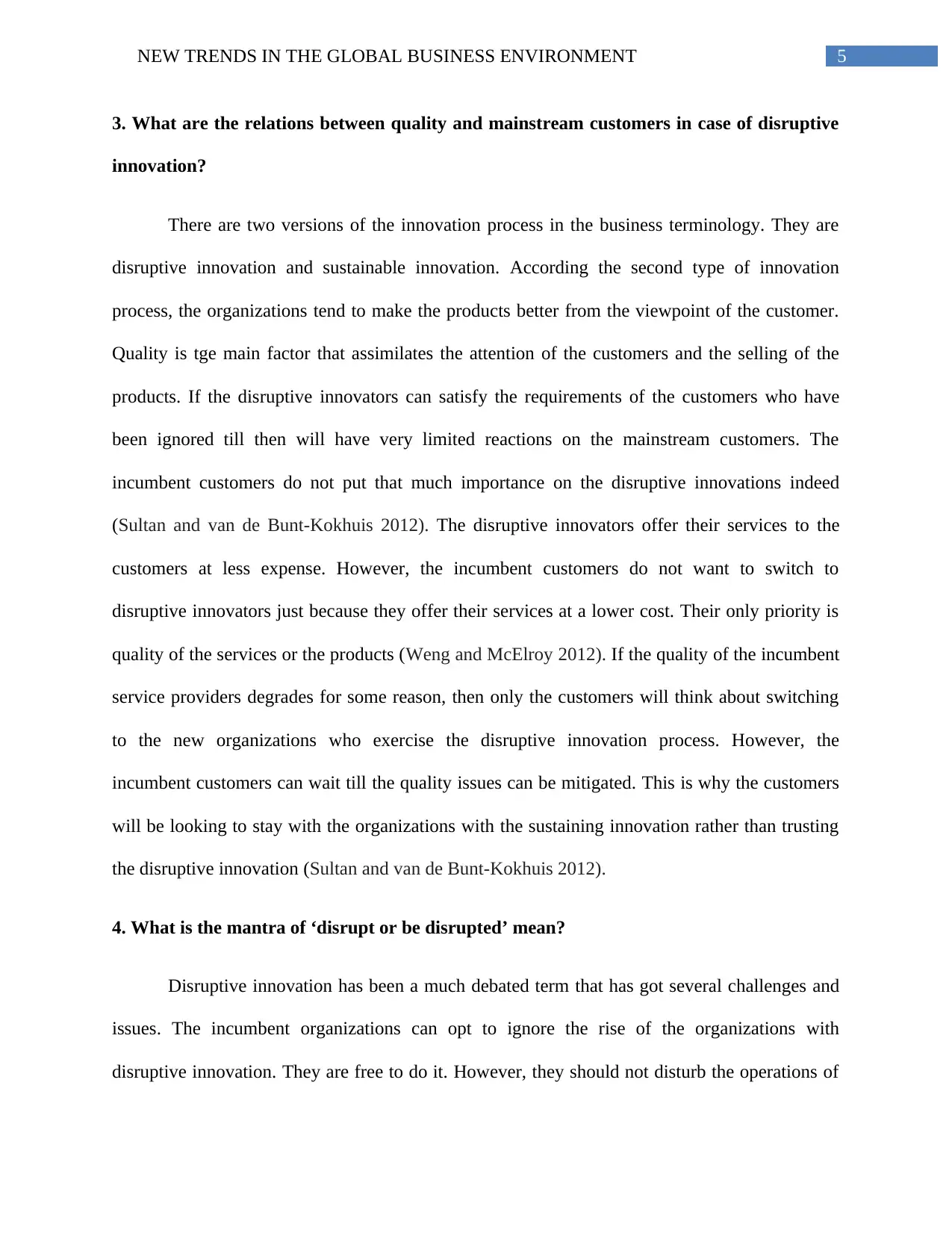
5NEW TRENDS IN THE GLOBAL BUSINESS ENVIRONMENT
3. What are the relations between quality and mainstream customers in case of disruptive
innovation?
There are two versions of the innovation process in the business terminology. They are
disruptive innovation and sustainable innovation. According the second type of innovation
process, the organizations tend to make the products better from the viewpoint of the customer.
Quality is tge main factor that assimilates the attention of the customers and the selling of the
products. If the disruptive innovators can satisfy the requirements of the customers who have
been ignored till then will have very limited reactions on the mainstream customers. The
incumbent customers do not put that much importance on the disruptive innovations indeed
(Sultan and van de Bunt-Kokhuis 2012). The disruptive innovators offer their services to the
customers at less expense. However, the incumbent customers do not want to switch to
disruptive innovators just because they offer their services at a lower cost. Their only priority is
quality of the services or the products (Weng and McElroy 2012). If the quality of the incumbent
service providers degrades for some reason, then only the customers will think about switching
to the new organizations who exercise the disruptive innovation process. However, the
incumbent customers can wait till the quality issues can be mitigated. This is why the customers
will be looking to stay with the organizations with the sustaining innovation rather than trusting
the disruptive innovation (Sultan and van de Bunt-Kokhuis 2012).
4. What is the mantra of ‘disrupt or be disrupted’ mean?
Disruptive innovation has been a much debated term that has got several challenges and
issues. The incumbent organizations can opt to ignore the rise of the organizations with
disruptive innovation. They are free to do it. However, they should not disturb the operations of
3. What are the relations between quality and mainstream customers in case of disruptive
innovation?
There are two versions of the innovation process in the business terminology. They are
disruptive innovation and sustainable innovation. According the second type of innovation
process, the organizations tend to make the products better from the viewpoint of the customer.
Quality is tge main factor that assimilates the attention of the customers and the selling of the
products. If the disruptive innovators can satisfy the requirements of the customers who have
been ignored till then will have very limited reactions on the mainstream customers. The
incumbent customers do not put that much importance on the disruptive innovations indeed
(Sultan and van de Bunt-Kokhuis 2012). The disruptive innovators offer their services to the
customers at less expense. However, the incumbent customers do not want to switch to
disruptive innovators just because they offer their services at a lower cost. Their only priority is
quality of the services or the products (Weng and McElroy 2012). If the quality of the incumbent
service providers degrades for some reason, then only the customers will think about switching
to the new organizations who exercise the disruptive innovation process. However, the
incumbent customers can wait till the quality issues can be mitigated. This is why the customers
will be looking to stay with the organizations with the sustaining innovation rather than trusting
the disruptive innovation (Sultan and van de Bunt-Kokhuis 2012).
4. What is the mantra of ‘disrupt or be disrupted’ mean?
Disruptive innovation has been a much debated term that has got several challenges and
issues. The incumbent organizations can opt to ignore the rise of the organizations with
disruptive innovation. They are free to do it. However, they should not disturb the operations of
⊘ This is a preview!⊘
Do you want full access?
Subscribe today to unlock all pages.

Trusted by 1+ million students worldwide
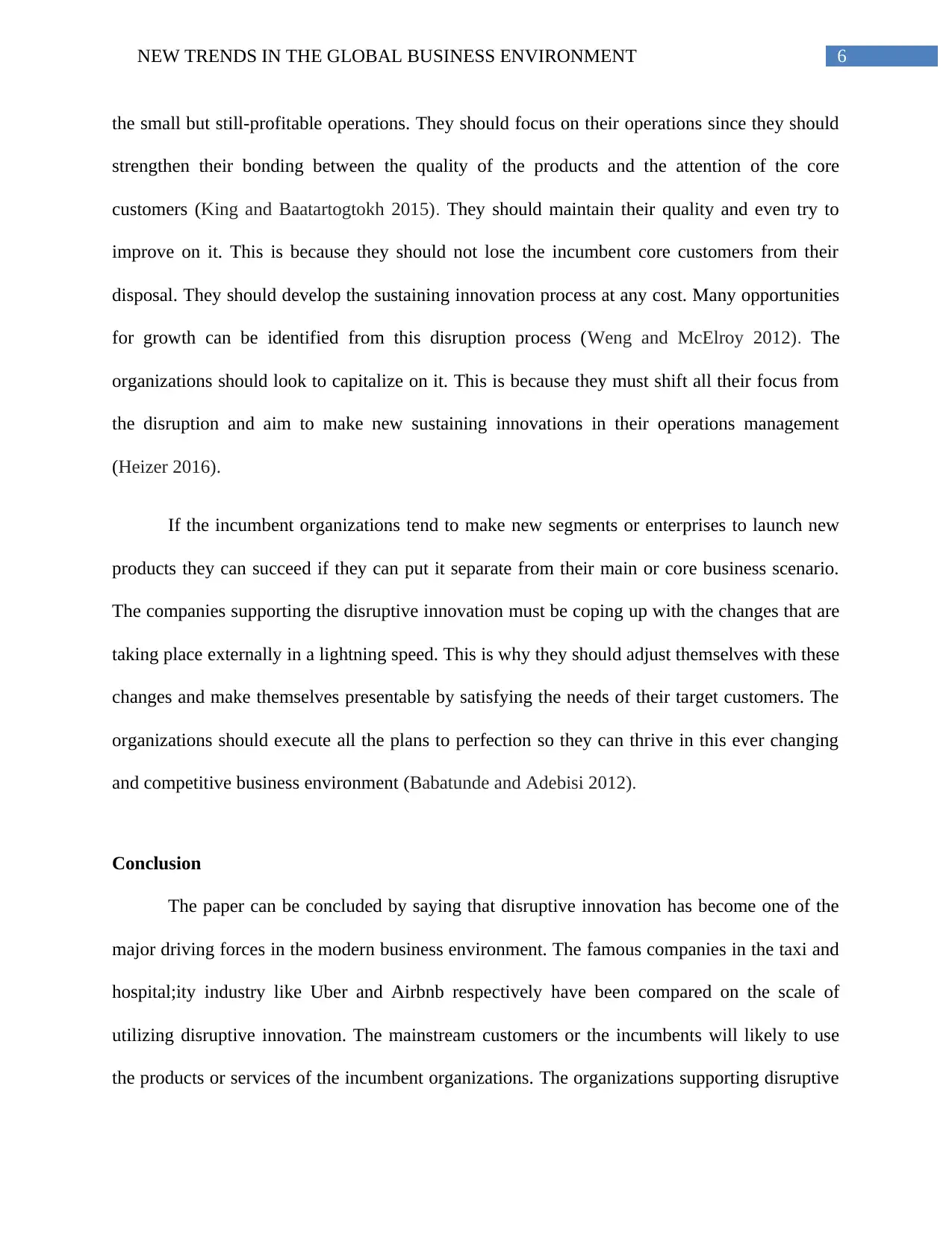
6NEW TRENDS IN THE GLOBAL BUSINESS ENVIRONMENT
the small but still-profitable operations. They should focus on their operations since they should
strengthen their bonding between the quality of the products and the attention of the core
customers (King and Baatartogtokh 2015). They should maintain their quality and even try to
improve on it. This is because they should not lose the incumbent core customers from their
disposal. They should develop the sustaining innovation process at any cost. Many opportunities
for growth can be identified from this disruption process (Weng and McElroy 2012). The
organizations should look to capitalize on it. This is because they must shift all their focus from
the disruption and aim to make new sustaining innovations in their operations management
(Heizer 2016).
If the incumbent organizations tend to make new segments or enterprises to launch new
products they can succeed if they can put it separate from their main or core business scenario.
The companies supporting the disruptive innovation must be coping up with the changes that are
taking place externally in a lightning speed. This is why they should adjust themselves with these
changes and make themselves presentable by satisfying the needs of their target customers. The
organizations should execute all the plans to perfection so they can thrive in this ever changing
and competitive business environment (Babatunde and Adebisi 2012).
Conclusion
The paper can be concluded by saying that disruptive innovation has become one of the
major driving forces in the modern business environment. The famous companies in the taxi and
hospital;ity industry like Uber and Airbnb respectively have been compared on the scale of
utilizing disruptive innovation. The mainstream customers or the incumbents will likely to use
the products or services of the incumbent organizations. The organizations supporting disruptive
the small but still-profitable operations. They should focus on their operations since they should
strengthen their bonding between the quality of the products and the attention of the core
customers (King and Baatartogtokh 2015). They should maintain their quality and even try to
improve on it. This is because they should not lose the incumbent core customers from their
disposal. They should develop the sustaining innovation process at any cost. Many opportunities
for growth can be identified from this disruption process (Weng and McElroy 2012). The
organizations should look to capitalize on it. This is because they must shift all their focus from
the disruption and aim to make new sustaining innovations in their operations management
(Heizer 2016).
If the incumbent organizations tend to make new segments or enterprises to launch new
products they can succeed if they can put it separate from their main or core business scenario.
The companies supporting the disruptive innovation must be coping up with the changes that are
taking place externally in a lightning speed. This is why they should adjust themselves with these
changes and make themselves presentable by satisfying the needs of their target customers. The
organizations should execute all the plans to perfection so they can thrive in this ever changing
and competitive business environment (Babatunde and Adebisi 2012).
Conclusion
The paper can be concluded by saying that disruptive innovation has become one of the
major driving forces in the modern business environment. The famous companies in the taxi and
hospital;ity industry like Uber and Airbnb respectively have been compared on the scale of
utilizing disruptive innovation. The mainstream customers or the incumbents will likely to use
the products or services of the incumbent organizations. The organizations supporting disruptive
Paraphrase This Document
Need a fresh take? Get an instant paraphrase of this document with our AI Paraphraser

7NEW TRENDS IN THE GLOBAL BUSINESS ENVIRONMENT
innovation will be able to compete with the incumbents by providing the best quality services.
This mini literature review has been conducted in order to highlight the different aspects that
surround disruptive innovation technology and process.
innovation will be able to compete with the incumbents by providing the best quality services.
This mini literature review has been conducted in order to highlight the different aspects that
surround disruptive innovation technology and process.
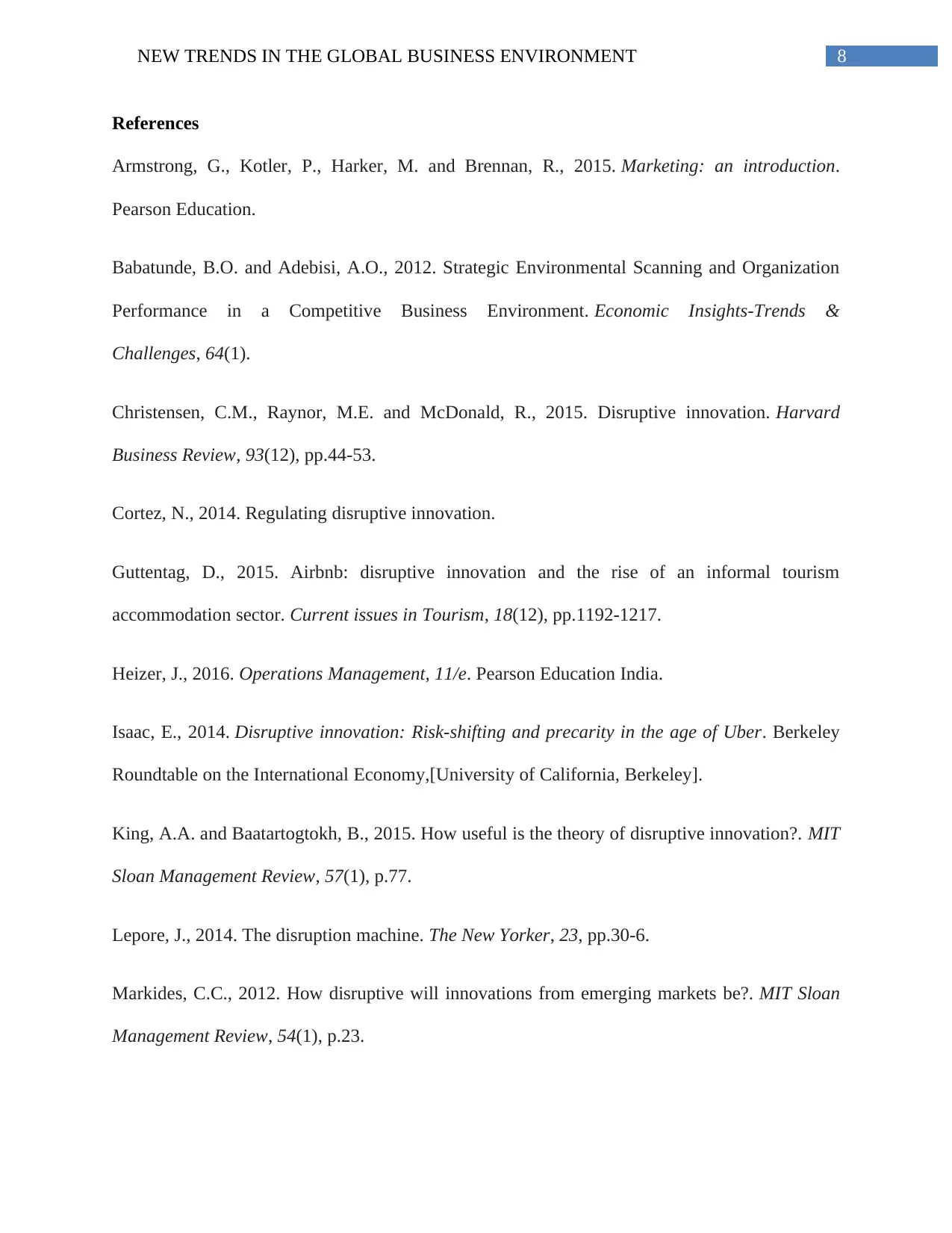
8NEW TRENDS IN THE GLOBAL BUSINESS ENVIRONMENT
References
Armstrong, G., Kotler, P., Harker, M. and Brennan, R., 2015. Marketing: an introduction.
Pearson Education.
Babatunde, B.O. and Adebisi, A.O., 2012. Strategic Environmental Scanning and Organization
Performance in a Competitive Business Environment. Economic Insights-Trends &
Challenges, 64(1).
Christensen, C.M., Raynor, M.E. and McDonald, R., 2015. Disruptive innovation. Harvard
Business Review, 93(12), pp.44-53.
Cortez, N., 2014. Regulating disruptive innovation.
Guttentag, D., 2015. Airbnb: disruptive innovation and the rise of an informal tourism
accommodation sector. Current issues in Tourism, 18(12), pp.1192-1217.
Heizer, J., 2016. Operations Management, 11/e. Pearson Education India.
Isaac, E., 2014. Disruptive innovation: Risk-shifting and precarity in the age of Uber. Berkeley
Roundtable on the International Economy,[University of California, Berkeley].
King, A.A. and Baatartogtokh, B., 2015. How useful is the theory of disruptive innovation?. MIT
Sloan Management Review, 57(1), p.77.
Lepore, J., 2014. The disruption machine. The New Yorker, 23, pp.30-6.
Markides, C.C., 2012. How disruptive will innovations from emerging markets be?. MIT Sloan
Management Review, 54(1), p.23.
References
Armstrong, G., Kotler, P., Harker, M. and Brennan, R., 2015. Marketing: an introduction.
Pearson Education.
Babatunde, B.O. and Adebisi, A.O., 2012. Strategic Environmental Scanning and Organization
Performance in a Competitive Business Environment. Economic Insights-Trends &
Challenges, 64(1).
Christensen, C.M., Raynor, M.E. and McDonald, R., 2015. Disruptive innovation. Harvard
Business Review, 93(12), pp.44-53.
Cortez, N., 2014. Regulating disruptive innovation.
Guttentag, D., 2015. Airbnb: disruptive innovation and the rise of an informal tourism
accommodation sector. Current issues in Tourism, 18(12), pp.1192-1217.
Heizer, J., 2016. Operations Management, 11/e. Pearson Education India.
Isaac, E., 2014. Disruptive innovation: Risk-shifting and precarity in the age of Uber. Berkeley
Roundtable on the International Economy,[University of California, Berkeley].
King, A.A. and Baatartogtokh, B., 2015. How useful is the theory of disruptive innovation?. MIT
Sloan Management Review, 57(1), p.77.
Lepore, J., 2014. The disruption machine. The New Yorker, 23, pp.30-6.
Markides, C.C., 2012. How disruptive will innovations from emerging markets be?. MIT Sloan
Management Review, 54(1), p.23.
⊘ This is a preview!⊘
Do you want full access?
Subscribe today to unlock all pages.

Trusted by 1+ million students worldwide
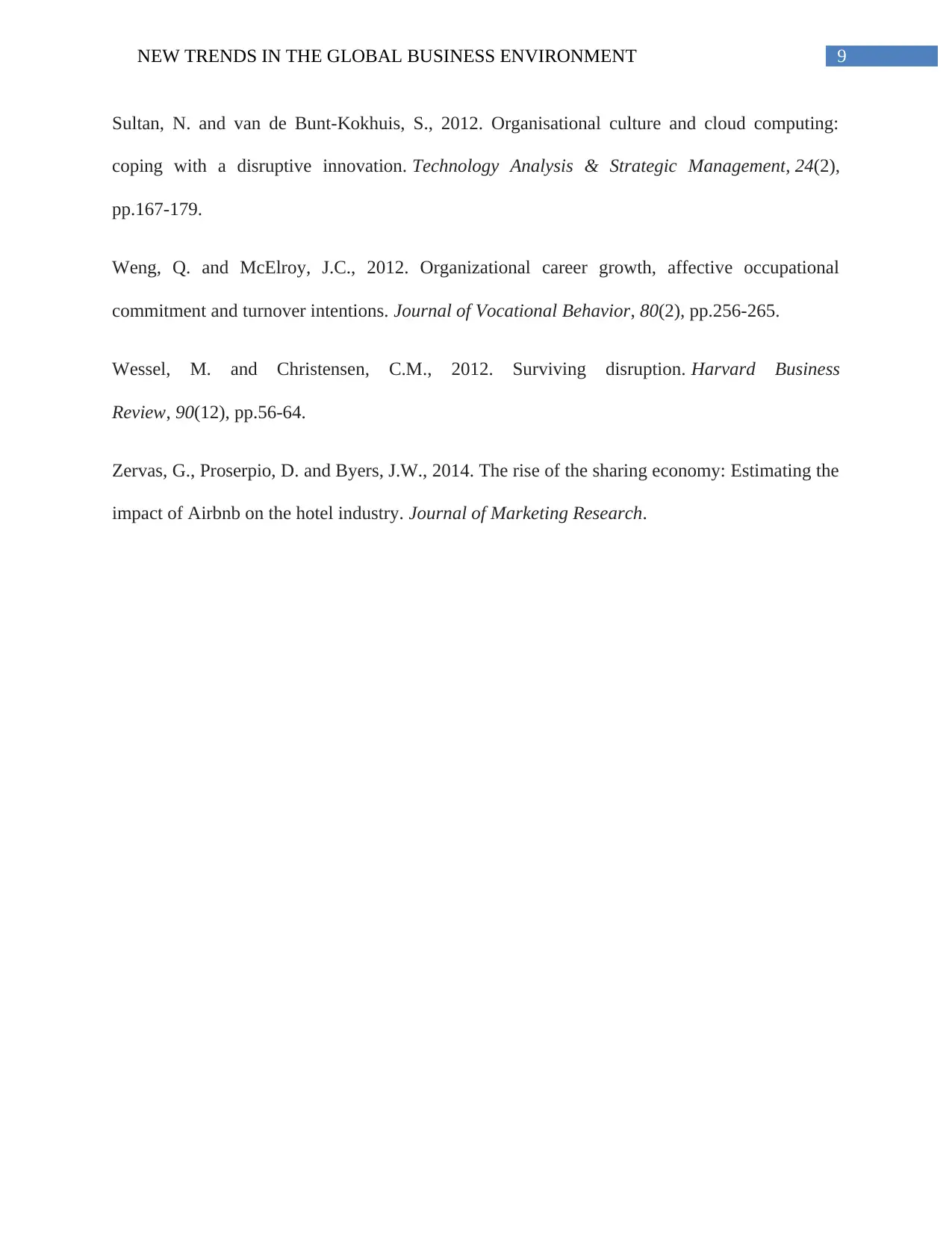
9NEW TRENDS IN THE GLOBAL BUSINESS ENVIRONMENT
Sultan, N. and van de Bunt-Kokhuis, S., 2012. Organisational culture and cloud computing:
coping with a disruptive innovation. Technology Analysis & Strategic Management, 24(2),
pp.167-179.
Weng, Q. and McElroy, J.C., 2012. Organizational career growth, affective occupational
commitment and turnover intentions. Journal of Vocational Behavior, 80(2), pp.256-265.
Wessel, M. and Christensen, C.M., 2012. Surviving disruption. Harvard Business
Review, 90(12), pp.56-64.
Zervas, G., Proserpio, D. and Byers, J.W., 2014. The rise of the sharing economy: Estimating the
impact of Airbnb on the hotel industry. Journal of Marketing Research.
Sultan, N. and van de Bunt-Kokhuis, S., 2012. Organisational culture and cloud computing:
coping with a disruptive innovation. Technology Analysis & Strategic Management, 24(2),
pp.167-179.
Weng, Q. and McElroy, J.C., 2012. Organizational career growth, affective occupational
commitment and turnover intentions. Journal of Vocational Behavior, 80(2), pp.256-265.
Wessel, M. and Christensen, C.M., 2012. Surviving disruption. Harvard Business
Review, 90(12), pp.56-64.
Zervas, G., Proserpio, D. and Byers, J.W., 2014. The rise of the sharing economy: Estimating the
impact of Airbnb on the hotel industry. Journal of Marketing Research.
Paraphrase This Document
Need a fresh take? Get an instant paraphrase of this document with our AI Paraphraser
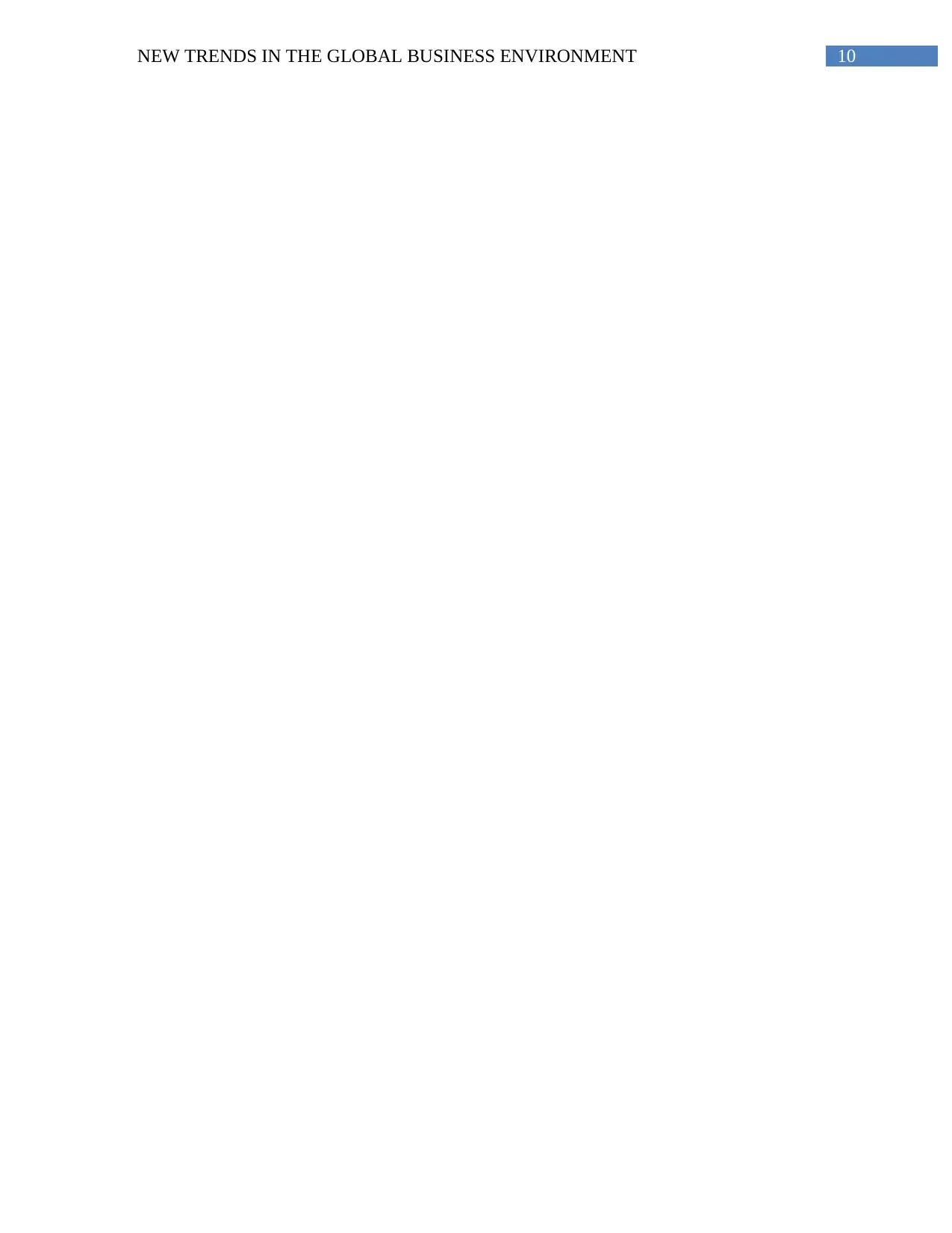
10NEW TRENDS IN THE GLOBAL BUSINESS ENVIRONMENT
1 out of 11
Related Documents
Your All-in-One AI-Powered Toolkit for Academic Success.
+13062052269
info@desklib.com
Available 24*7 on WhatsApp / Email
![[object Object]](/_next/static/media/star-bottom.7253800d.svg)
Unlock your academic potential
Copyright © 2020–2025 A2Z Services. All Rights Reserved. Developed and managed by ZUCOL.




